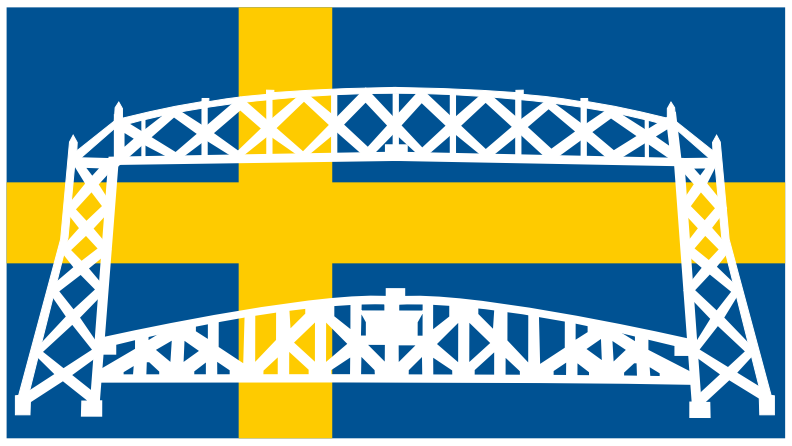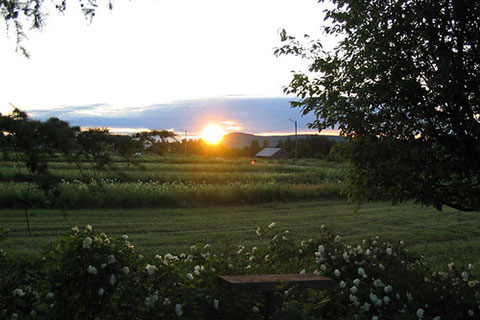Midsommar 2021
Midsommar in Sweden
Midsommar is a popular occasion of great festivity in Sweden. It is the time when summer days are longest and in northern Sweden the time of the Midnight Sun. In Sweden, Midsommar is celebrated on the weekend nearest June 24th, Johannes Döparens dag, the day of John the Baptist, with Midsommar Day held on Saturday.
On the morning of Midsommar Eve, Swedes decorate their homes, cars, churches and dancing pavilions with leafy branches and garlands of flowers. After noon, they gather around the Maypole, raise it in the middle of the village square, and dancing begins. Midsommar always ends with delicious food and enjoying the company of their friends and neighbors.
Ulla's Midsommar Experience - Let's Read & Listen
Here’s how Ulla Gustafsson-Carlson, fellow member of the Swedish Cultural Society (SCS) of Duluth and Swedish native, describes her experience around Midsummer (Midsommar in Swedish) growing up in Sweden. The text is read by fellow SCS member Inger Lauritsen, also a Swedish native.
English (Engelska)
Midsommar was my favorite holiday while growing up in Sweden. It takes place when everything is green and so many wildflowers are in full bloom. Midsommar Eve is now celebrated on the Friday closest to June 24.
Preparations usually begin the night before when you start gathering as many flowers and birch branches as you can find to be used for dressing the midsommar pole. (I am not using the name Maypole. I believe that originates from England and I have also encountered it in Germany where people decorate a pole in May to celebrate spring.)
On Midsommar Eve, we usually participated in decorating the pole. In my case, we raised a pole in the park next to the hospital where personnel and any patients who were well enough to be brought outside participated. The local “Spelmanslag” and “Folkdanslag” (Musicians and folk dancers) would arrive and lead in dancing and singing after the pole had been raised. Then followed fika: cardamom buns, many different kinds of cookies and of course “tårta,” (usually fresh strawberry cake), coffee for the adults and “saft” (a type of fruit syrup with added water).
At the same time there were other midsommar gatherings going on, usually in a municipal park. Or many families created their own celebration at their sommarstuga (vacation home). Later on we had a meal that traditionally included the new little potatoes that were ready for harvest at this time, boiled with lots of dill, and served with “Matjesill” (a type of herring), and sour cream sauce loaded with dill. The adults liked to add a “nubbe.” (Swedish equivalent to Aquavit).
Celebrations went on long into the night, since this time of the year there is so much daylight and just a few hours of night depending on where in Sweden you live. Traditionally, girls would pick a bouquet of seven different kinds of flowers that night and place them under their pillow and they would dream of their future husband.
If you were lucky, the weather would cooperate. But I remember many midsommars in pouring rain and cold. But we always tried to carry on the celebration anyway.
Swedish (Svenska)
Midsommar var min favorithelg när jag växte upp i Sverige. Den äger rum när allt är grönt och i full blom. Midsommarafton firas nu på fredagen närmast den 24 juni.
Förberedelserna börjar vanligtvis kvällen innan när man börjar samla så många blommor och björkgrenar som man kan hitta för att klä midsommarstången med. (Jag använder inte namnet Maypole. Jag tror att det kommer från England och jag har också stött på det i Tyskland där människor dekorerar en stolpe i maj för att fira våren.)
På midsommarafton deltog vi alla i att klä stången. I mitt fall reste vi en stång i parken bakom sjukhuset där personal och alla patienter som var tillräckligt bra för att föras ut deltog. Det lokala spelmanslaget och folkdansarna anlände för att leda dansen och sången efter att stången hade rests. Sedan följde fika: kardemumbullar, många olika sorters kakor och naturligtvis ”tårta”, (vanligtvis färsk jordgubbstårta), kaffe för de vuxna och ”saft” för barnen(en typ av fruktjuice utspädd med vatten).
Samtidigt pågick andra midsommar fester, vanligtvis i en kommunal park. Eller många familjer skapade sin egen fest på deras sommarstuga (fritidshus). Senare åt vi en måltid som traditionellt inkluderade de nya små potatiserna som var färdiga för skörd vid den här tiden, kokta med mycket dill och serverades med ”Matjesill” (en typ av sill) och gräddfilssås. De vuxna gillade att lägga till en “nubbe”. (Svenskt brännvin motsvarande Aquavit).
Firandet pågick långt in på natten, eftersom det är så mycket dagsljus och bara några timmar av lätt nattmörker beroende på var i Sverige du bor. Traditionellt skulle flickorna plocka en bukett med sju olika sorters blommor den kvällen och lägga dem under kudden och drömma om sin framtida make.
Om du hade tur var vädret vackert o varmt. Men jag kommer ihåg många midsommar i hällande regn och kyla. Men vi försökte alltid fortsätta firandet ändå.
More on Midsommar
To learn more about Midsommar in Sweden, please open the following PDF file.




